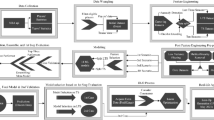Abstract
A model is proposed for predicting the result of a football match from the previous results of both teams. This model underlies the method of identifying nonlinear dependencies by fuzzy knowledge bases. Acceptable simulation results can be obtained by tuning fuzzy rules using tournament data. The tuning procedure implies choosing the parameters of fuzzy-term membership functions and rule weights by a combination of genetic and neural optimization techniques.
Similar content being viewed by others
REFERENCES
A. G. Ivakhnenko and V.G. Lapa, Prediction of Random Processes [in Russian], Naukova Dumka, Kiev (1971).
S. Markidakis, S. C. Wheelwright, and R. J. Hindman, Forecasting: Methods and Applications, John Wiley and Sons, New York (1998).
J. Mingers, “Rule induction with statistical data — a comparison with multiple regression,” Oper. Res. Soc., 38, 347–351 (1987).
K.A. Willoughby, “Determinants of success in the CFL: A logistic regression analysis,” in: Proc. Nat. Ann. Meeting to the Dec. Sci., Decision Sci. Inst., Atlanta, USA, 2 (1997), pp. 1026–1028.
M. E. Glickman and H. S. Stern, “A state-space model for national football league scores,” J. Amer. Statist. Assoc., 93, 25–35 (1998).
H. Stern, “On probability of winning a football game,” The Amer. Statist., 45, 179–183 (1991).
M. I. Dixan and S. C. Coles, “Modeling association football scores and inefficiencies in the football betting market,” Appl. Statist., 46, No.2, 265–280 (1997).
R.H. Koning, “Balance in competition in Dutch soccer,” The Statistician, 49, 419–431 (2000).
H. Rue and O. Salvensen, “Prediction and retrospective analysis of soccer matches in a league,” The Statistician, 49, 399–418 (2000).
S. Walczar and J. Krause, “Chaos neural networks and gaming,” in: Proc. 3rd Golden West Intern. Conf., Intelligent Systems, Las Vegas, NV, USA, Kluwer, Dordrecht (1995), pp. 457–466.
M. C. Purucker, “Neural network quarterbacking,” IEEE Potentials, 15, No.3, 9–15 (1996).
E. M. Condon, B. L. Colden, and E. A. Wasil, “Predicting the success of nations at the summer Olympic using neural networks,” Comput. Oper. Res., 26, No.13, 1243–1265 (1999).
L. A. Zadeh, “Outline of a new approach to the analysis of complex systems and decision process,” IEEE Trans., SMC, 3, No.1, 28–44 (1973).
A. Rotshtein, “Design and tuning of fuzzy rule-based systems for medical diagnosis,” in: N.-H. Teodorescu, A. Kandel, and L. Gain (eds.), Fuzzy and Neuro-Fuzzy Systems in Medicine, CRC Press, New York (1998), pp. 243–289.
A. P. Rotshtein, Intelligent Identification Techniques: Fuzzy Sets, Neural Networks, and Genetic Algorithms [in Russian], Universum, Vinnitsa (1999).
A. P. Rotshtein and D. I. Katel'nikov, “Identification of nonlinear objects by fuzzy knowledge bases,” Cyb. Syst. Anal., Vol. 34, No.5, 676–683 (1998).
A. P. Rotshtein, E. E. Loiko, and D. I. Katel'nikov, “Prediction of the number of diseases on the basis of expert-linguistic information,” Cyb. Syst. Anal., Vol. 35, No.2, 335–342 (1999).
A. P. Rotshtein and Yu. I. Mityushkin, “Neurolinguistic identification of nonlinear dependences,” Cyb. Syst. Anal., Vol. 36, No.2, 179–187 (2000).
A. P. Rotshtein and S. D. Shtovba, “Control of a dynamic system based on a fuzzy knowledge base,” Avtom. Vych. Tekhn., No. 2, 23–30 (2001).
M. Gen and R. Cheng, Genetic Algorithms and Engineering Design, John Wiley and Sons, New York (1997).
Ya. Z. Tsypkin, Fundamentals of the Information Theory of Identification [in Russian], Nauka, Moscow (1984).
Author information
Authors and Affiliations
Additional information
__________
Translated from Kibernetika i Sistemnyi Analiz, No. 4, pp. 171–184, July–August 2005.
Rights and permissions
About this article
Cite this article
Rotshtein, A.P., Posner, M. & Rakityanskaya, A.B. Football Predictions Based on a Fuzzy Model with Genetic and Neural Tuning. Cybern Syst Anal 41, 619–630 (2005). https://doi.org/10.1007/s10559-005-0098-4
Received:
Issue Date:
DOI: https://doi.org/10.1007/s10559-005-0098-4




